

Their Uses for Food and Medicine

My love of plants and the desire to learn about their uses in the past has led me to many exciting discoveries. Because I lived in the central Texas area at the time of this study the majority of the plants listed here will be those species found in Central Texas. Pictures were produced by the Texas A&M Bioinformatics Working Group which can be found at the Vascular Plant Image Gallery in the Flowering Gateway.

Amaranth (Alternanthera sp.)
The amaranth can be cooked as greens or the succulent stems and leaves can be eaten raw. This plant is very high in calcium, phosphorus, and potassium. The spikes of these plants also produce numerous tiny black seeds which are high in protein. The leaves contain oxalic acid which tends to bind calcium restricting its absorption by the body.
Blackhaw (Viburnum rufidulum)
The blue-black drupes produced by this plant have a dry sweet pulp available late summer through the fall.
Chenopod (Chenopodium albescens)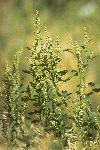
The chenopods belong to the same family as beets, chard, and spinach. They can be cooked or eaten raw, however, cooking will destroy the naturally high amounts of vitamin C. They are also high in vitamin A, calcium, and potassium. The seeds can be cooked or ground into a meal for an added source of protein. Like spinach, the chenopods contain oxalic acid which tends to bind calcium.
Dewberry (Rubus flagillaris)
The fruit of the dewberry can be eaten raw, cooked, or dried. The tender shoots of the early spring can be peeled and eaten raw. Dewberries are a good source for potassium as well as vitamins A and C.
Grape (Vitis sp.)
Grapes can be eaten raw, cooked, or dried. The mustang grape (Vitis mustangensis) should not be gathered until after the first couple of frosts which sometimes help reduce the sourness found in that species. It is a good source of potassium and vitamin A. Grape leaves are loaded with calcium, iron, potassium, and vitamins A and niacin.
Green Brier (Smilax sp.)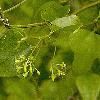
New growth can be cut and eaten raw or they can be prepared as a cooked green. The roots can be brewed for a sarsaparilla-like beverage.
Ground Cherry (Physalis sp.)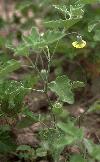
You can gather ground cherries when they are green, but you must let them ripen before you eat them. They can be eaten raw or cooked for a good source of vitamins A and niacin.
Hackberry (Celtis laevigata)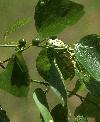
Hackberry fruits, available summer and fall, are a good source of calcium and protein.
Hawthorne (Crataegus sp.)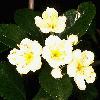
The fruit of the hawthorne can be eaten raw, made into a drink, or dried for later use.
Honey Locust (Gleditsia texana)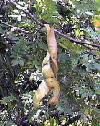
The pods of the honey locust have a sugar-sweet pulp and the young pods can be eaten raw, or boiled and eaten like string beans. They can also be pounded and soaked in water to make a beverage. Both the fruit and seeds are good sources of calcium and phosphorus.
Live Oak (Quercus virginiana)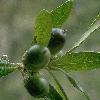
Acorns must first be leached of the tannic acids they contain. To do this they are shelled and placed in water to be boiled. The water must be emptied and replaced several times until it remains clear. The acorns are then dried and ground into flour. Acorn flour is high in protein, calcium, phosphorus, potassium, and niacin.
Nettle (Urtica chamaedryoides)
Nettles must be cooked to avoid the stinging hairs on the leaves and stems. They are rich in protein, as well as vitamins A and C. Do not confuse the true nettle with the bull nettle (Cnidoscolus texanus) because the bull nettle has poisonous leaves.
Onion (Allium sp.)
The wild onions are like cultivated onions, they are a good source for vitamin C and potassium.
Peppergrass (Lepidium sp.)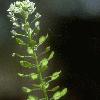
Peppergrass is in the Brassicaceae family like Tansy mustard. Like mustards it can be eaten raw or as cooked greens. It is high in vitamin C, calcium, and potassium. It is also a good source for thiamin and riboflavin.
Persimmon (Diospyros virginiana)
The fruits of the persimmon are best gathered after the first frost. They can be eaten raw, dried, or cooked. The persimmon is high in potassium and vitamin C.
Pokeweed (Phytolacca decandra)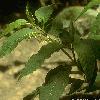
These plants are highly poisonous so only the new shoots should be used that contain no woody parts. It has to be boiled and drained and then boiled again several times to eliminate the poisons. Pokeweeds are high in vitamins A and C.
Portulaca (Claytonia virginica)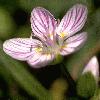
The leaves, flowers, pods, and stems can be eaten raw, boiled, or steamed. It is high in potassium and vitamin A, and is a good source for calcium and vitamin C. I have heard that the ashes of burned portulaca make a good substitute for salt.
Pricklypear (Opuntia sp.)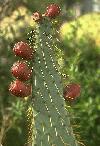
The blooms, fruit, seed, and entire plant of the pricklypear can be eaten. In the summer the blooms and pads can be eaten raw, cooked, or dried. Both are high in calcium, and the blooms are high in vitamin C. In the fall the fruits and seeds as well as the pads can be used. The fruits are high in potassium and the seeds are a good source for vitamin C.
Redbud (Cercis canadensis)
The flowers appear in late winter and early spring and can be eaten raw or cooked. They have a slightly sour flavor and are high in vitamin C. The young green pods may also be eaten raw or cooked.
Sumac (Rhus aromatica)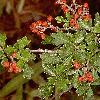
Sumacs are related to the cashews, mangoes, and poison ivy and thus some people may have an allergic reaction to it. The drupes of this plant are ripe in the early fall and can be used to produce a lemonade-like drink that is high in vitamin C. The fruits should be removed from the stems and soaked in cold water to avoid releasing the tannins found in the seeds.
Sunflower (Helianthus sp.)
Sunflower seeds are eaten either raw or cooked. A cooked unopen flower bud has a taste reminiscent of artichokes. The seeds are high in protein and phosphorus.
Tansy Mustard (Descurainia pinnata)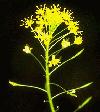
The leaves can be eaten raw or cooked for greens like any other mustard. They are high in vitamins A and C, as well as, calcium and potassium. They are also a good source of thiamin and riboflavin.
Thistle (Cirsium sp.)
Except for the spines found on the leaves, stems, and flower bases, the rest of this plant is considered edible. They can be eaten raw after removing the spines or cooked for a good source of vitamin A.
Turk's Cap (Malvaviscus arboreus sp.)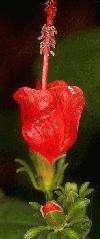
You can eat the flowers, fruits, and young leaves of Turk's Cap either raw or cooked. They are high in calcium and vitamins A and C.
Yellow Passionflower (Passiflora lutea)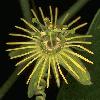
The fruit of the passionflower contains mostly juice and seeds. The juice is consumed as a beverage or used with other foods to give them a sweet flavor. The fruit is high in potassium, and vitamins A, C, and niacin.
Yellow Stonecrop (Sedum nuttallianum)
The fleshy leaves and stems of sedums can be eaten raw, steamed, or boiled. They are slightly tart and crisp and mix well with stronger flavored greens.
Yellow Woodsorrel (Oxalis dillenii)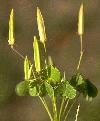
The fruit, flower, leaves, and roots are eaten raw or cooked. They are enjoyed because of the salty/sour flavor. They contain oxalic acids so they should be eaten in moderation.
Violet (Viola sp.)
The blooms and leaves of the violet can be eaten raw or cooked. The leaves are very high in vitamins A and C. The blooms can be gathered for eating in the spring, and the leaves are best gathered late fall and early spring because they will turn bitter towards the summer.

My favorite plant links...

 
Disclaimer...The author does not accept responsibility for identifications made by persons using this guide, nor for any effects that may arise from ingesting a wild plant. Although many species are known to be edible for many people, it is not possible to predict an individuals reaction to a particular plant. Therefore, the author does not accept responsibility for any personal experimentation.
|









